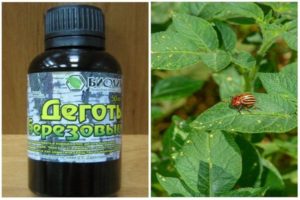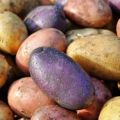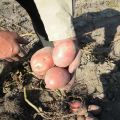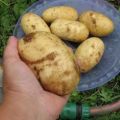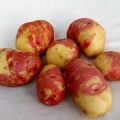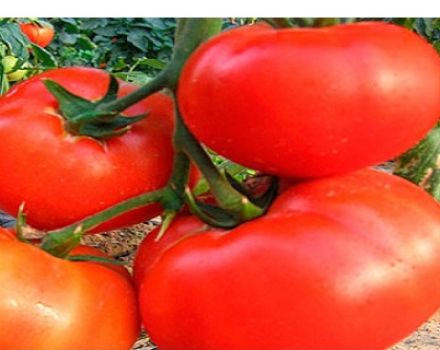Description of the Kiwi potato variety, its characteristics and yield
Kiwi potatoes are a product of amateur selection. Gardeners dream of getting a good harvest on their weave. Often they are faced with the problem of limited space. I would like to plant potatoes, but there is not enough space.
The plant is a godsend for gardeners. He pleases with productivity and unpretentiousness. The root crop easily tolerates temperature fluctuations. It makes requirements only for illumination.
All parts of the plant are not damaged by pests. A zealous gardener can save on the purchase of insecticides. This feature of the variety will interest the supporters of organic farming. A "clean" root crop gets on the table.
Underground curiosity
The variety was bred by amateur gardeners. It was not included in the State Register of Vegetable Crops. Observations were not made by anyone. Planting material is not sold in specialized centers.
But in the markets or from amateur potato growers it is possible to get a certain amount of tubers. But no one will vouch for the purity of the seed.
The description of the variety does not leave indifferent gardeners:
- It differs from ordinary potatoes in emerald green foliage. The edges of the plates are cut.
- The stems and leaves are covered with downy hairs. Common potatoes have smooth tops.
- The bush does not fall. Stretches 60–80 cm.
- Lilac flowers are connected in lush baskets. Attracts pollinating insects. Blooms reluctantly. In summer with few sunny days it does not bloom at all.
- A distinctive feature of the variety is the uniformity of tubers. One bush produces fruits of almost the same size.
- Does not get sick with late blight, scab, rot, Alternaria. Not damaged by pests.

Ripens in 120–130 days after germination. In cool summers, the term increases. With competent agricultural technology, it pleases with a yield of 3-4 kg / bush.
What attracts tubers?
The plant differs from its relatives in the appearance of the tubers. Gardeners are eager to learn about the typical traits of the variety. Characteristics of Kiwi potato fruit:
- dense, rough, olive brown skin;
- the pulp is white with a yellowish tinge;
- oval shape, even;
- high dry matter content in tubers;
- the consistency of boiled potatoes is crumbly, granular.
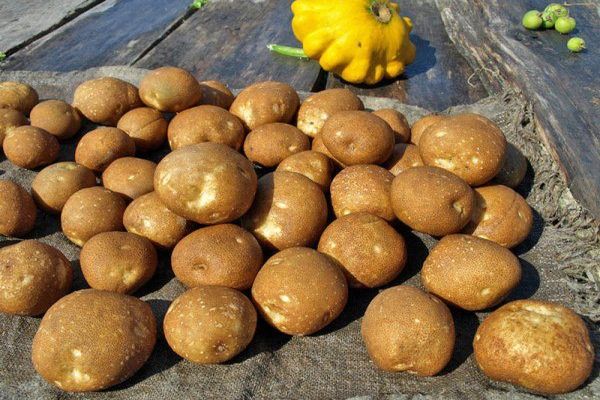
For the first time, a gardener planting a variety should prepare for an almost complete lack of taste.... There is also no characteristic rich "potato" aroma.
The root vegetable is cooked for a long time - at least 40 minutes. Frying is impossible - the middle remains moist for a long time, and the crust burns. But the puree is excellent in consistency - perfect friability.
Grade value: transportability, marketability, long-term storage without losses. The thick peel prevents drying out and germination.
Gardeners who grow animals have found a good use for the crop. In the cold period, the tubers are steamed and then fed to pigs and poultry. This makes it easier for pets to tolerate low temperatures without additional heating costs.

The peculiarities of potatoes both attract and scare away gardeners. Still, it is worth trying to plant at least a few bushes. And then draw your own conclusions.
Is the variety genetically engineered?
The controversy on this topic does not subside. It is easy to understand that no precise research has been done on this issue. Gardeners themselves have to decide: GMO or not Kiwi variety.
It is not known where the potatoes came from. Some gardeners believe that they are from Belarus. Others argue that the homeland of the vegetable is Russia. In our country, two genetically modified varieties have been bred: Lugovskoy and Elizaveta. Both have been certified. They are allowed to be used for food, but not grown.
The aim of the Bioengineering Center is to increase resistance to diseases and pests. This is what makes us claim that Kiwi is a GMO product.
But in Belarus the Lasunok variety has been developed. It is resistant to pests due to the presence of bio-fiber. Pests do not like it because of the inability to digest it. The Colorado potato beetle does not lay eggs on the hairy parts of the plant.
Some agronomists doubt that potatoes are genetically modified products. The work requires a certain technical base. And similar characteristics are obtained using conventional selection methods.
How to grow a vegetable?
Kiwi potato is an unpretentious plant. Gardeners get a good harvest on any soil. But the variety is especially successful on light sandy loam.
The ridges should be prepared in the fall. The field needs to be dug up, organic fertilizer laid. In the spring, add humus. After a week, add a mineral complex for digging.
Landing requirements:
- the place should be chosen sunny (this is the only condition of the variety);
- plant only with germinated tubers;
- it is required to lay for germination 20 days before the intended planting;
- the tubers should be placed at a distance of 30 cm from each other;
- maintain 70 cm between rows;
- it is recommended to deepen it by 10 cm when planting on light soils, by 7 - on heavy soils;
- it is recommended to water by soaking the soil by 30–40 cm, three times per season;
- hilling is not performed (it is enough to rake the ground on both sides once);
- if the tops turn yellow, they should be mowed, after 10-12 days, dig it up;
- cleaning is recommended in dry sunny weather;
- leave the potatoes to dry in the sun for 2-3 hours (this will disinfect the tubers);
- for harvesting, you should use a pitchfork (they damage the tubers less);
- the dried crop is folded into nets or baskets, lowered into the basement.

You should not plant a curiosity after tomatoes, peppers, eggplants and strawberries. These plants require the same nutrients from the soil. They also have common diseases.
The Kiwi potato variety gives the maximum yield when planted using Dutch technology. The plant is placed in double rows with an interval of 70 cm.
Tubers should be stored in a ventilated dark room. The dense skin of the potato allows it to be stored until the next harvest without loss.
Gardeners' opinions
Summer residents give conflicting reviews about potatoes. Some consider unpretentiousness and productivity to be the advantage of the variety. They put up with taste.
Others appreciate the grainy texture, snowy color, and disease and pest resistance. Tubers are considered ideal for making mashed potatoes, fillings and pancakes.
Almost all gardeners are worried about the lack of a clear answer to the question: is the variety a product of genetic engineering.
